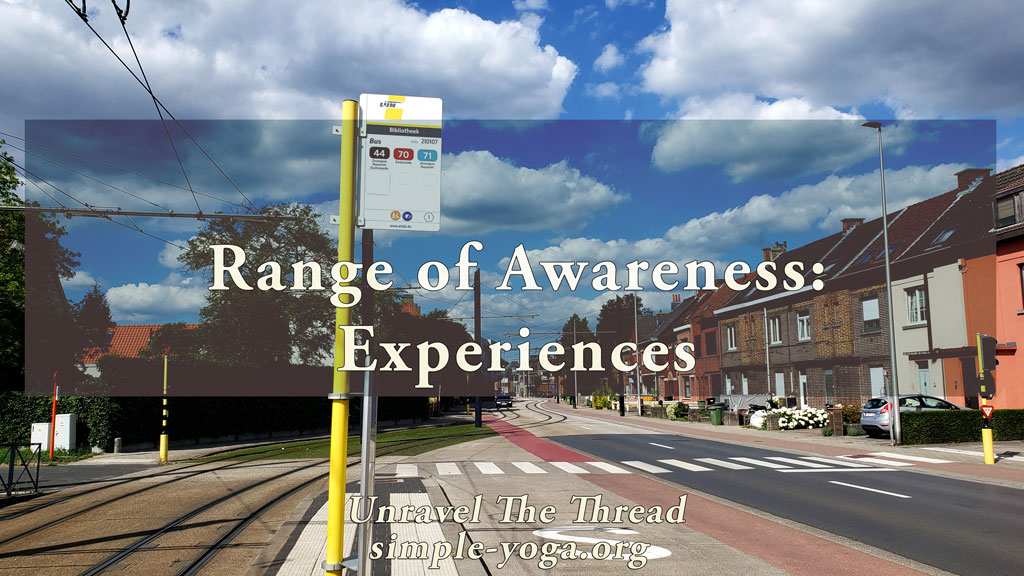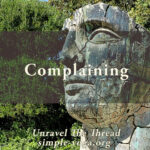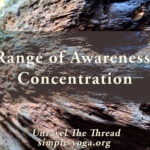Range of awareness and experiences

Weaving the thread of yoga: Range of Awareness and experiences
Previously we talked about Range of Awareness as a useful lens for exploring our sensations as well as our understanding so that we can make our yoga practice effective and meaningful. Range of Awareness reminds us that we are not digital beings, but natural organic processes. As human beings, like all other natural processes, we operate in gradual changes, just like the transformation that takes place every day in the transition from day to night and night to day. If we do not pay attention to the subtle changes that take place during these transitions, it may seem that it is suddenly getting dark or that the darkness is rapidly turning into light. However, when we take the time to focus our attention on observing the transformation between day and night, we begin to notice the gradual transitions that take place during both dusk and dawn. It is during twilight that we can notice subtle changes in the quality of light in the sky that occur almost imperceptibly, yet continuously. It is often easy to feel a sense of wonder as we sense the changes in color through the celestial vault during twilight. Most of us find that developing our sensitivity to natural processes enriches our experiences.
Since yoga is about being present (being embodied awareness), cultivating our range of awareness offers us the opportunity to expand our awareness to consciously participate in each now moment.
Let’s think about how experiences unfold. We can think about our experiences in terms of the world outside ourselves, our perception of external stimuli, and the process of perception. The yoga tradition often refers to this as the object (what is perceived), the subject (the perceiver), and the experience (the process of perception). For example, in Sutras 1.3 and 1.4 Patañjali mentions the distinction between identifying with experiences (citta vrtti) and witnessing them without becoming emotionally involved in them, which is a fundamental difference in perception. What is the relationship between these three elements in any experience, the object, the process of perception, and the perceiver? In several places in The Yoga Sutra, Patañjali explores the interactions between these three elements. In Chapter Four, Patañjali states that the objects in the world are real and that their existence is independent of being perceived. At the beginning of the first chapter of The Yoga Sutras, Patañjali also categorizes our ways of thinking into five groups: knowledge, misconceptions, imagination, memory, and dreams. These ways of thinking are how we perceive the objects and experiences in the world. When Sutra 1.5 says that these ways of thinking can be helpful or unhelpful depending on how they influence our perception, this can be interpreted as the process of perception. This idea is revisited in Chapter Four where, after talking about the objects in the world being real, Patañjali points out that our ways of being color our perception. Let’s recap: in yoga, we try to expand our awareness so that we can participate in our lives consciously and intentionally. We experience the world through our senses, and our mind makes sense of the sensory information it receives by using its archive of knowledge, misconceptions, imagination, memories, and dreams. Does this understanding of the perceptual process make sense to you? How does it relate to your own experience?
Patañjali elaborates on the relationship between the perceiver and the perceived in Sutra 2.17 when he says that the cause of our suffering is that we identify with what we perceive. In short, whatever we perceive is constantly changing, and our identification with these sensations and experiences creates a combination of likes (raga) and dislikes (dveshas); as our experiences change, we go through likes and dislikes in an endless cycle of enjoyment, irritation and suffering. In Sutra 2.18, Patañjali suggests that our experiences and sensations can be a vehicle for discernment helping us to clarify this fundamental distinction between what we perceive and our awareness. Here the notion of range of awareness can be useful. Our awareness can zoom in on a particular situation, experience, or sensation and become fully immersed in the experience. It may also be possible to zoom out from the surface level of the experience or situation and gain an expanded perspective. We can even engage in a practical exploration of how close we can zoom in and how expansive our perspective can become. What happens when we do this? Would it be possible to explore our range of awareness within the parameters of each of the eight limbs of yoga? Exploring our range of awareness in our practice of the eight limbs of yoga can help us understand the ideas presented by Patañjali in Sutras 1.41 to 1.45 when he suggests that there is a gradual process of refining our perception so that we can disentangle our knowledge from our perception. Our knowledge is a story that we constantly create about our current perception in combination with our memory. This story helps us make sense of the world by giving us ways to interpret the stimuli around us. How accurate are the stories our minds create? Which of these stories are helpful for consciously participating in our lives? Which stories are not helpful? Can our exploration of our range of awareness help us clarify some of our biases and perceptions? Can it also be useful in recognizing what Patañjali refers to in Sutra 4.17 when he says that our ways of being color our perception? Could this be useful in recognizing the ways in which we perceive other people and their actions? Could this be helpful in improving our ability to interact with ourselves and with others?
In yoga, Range of Awareness refers to bringing our conscious awareness into our intentions, thoughts, actions, and interactions, both to participate fully in our lives and to develop our ability to exquisitely modulate our systems. As a result, we can regulate muscular engagement, movement, breathing, focus, thought, and emotion in ways that enrich our experience and the quality of our participation. It is clear that PRESENCE is the defining aspect of Range of Awareness and what enables us to avoid the common tendency to act mechanically.
Recognizing that we have only one chance to participate in each moment can motivate us to devote some time and energy to exploring the Range of Awareness in our attitudes (through the yamas, niyamas and pratipaksha bhavana), in our postures and movements (asana), in our breathing (pranayama and chanting), in our sensory awareness and inner perception (pratyahara), in our focus (dharana) and sustained effortless concentration (dhyana), and in our experience of oneness (samadhi).
Applying the idea of Range of Awareness to our yoga practice enriches every aspect of our yoga practice while teaching us that awareness is the foundation of our existence. Rather than simply practicing a posture, breathing exercise, or meditation technique, Range of Awareness awakens our awareness to greater levels of subtlety in each experience, while also showing us our deeply interconnected wholeness. As a result, our yoga practice becomes a fascinating lifelong journey that sharpens our perception while acknowledging that our minds and bodies are in a constant process of change.
Here are some ideas for implementing Range of Awareness in your yoga practice, consider the possibilities between:
- Rigidity and flexibility
- Fast and ultra slow
- Relaxation and contraction
- Movement and stillness
- Sound and silence
- Compassion and Indifference
- Form and formlessness
- Single pointed focus and open awareness
- Emptiness and fullness
How can these different ranges be embodied? Can these ranges be applied to different aspects of you? What happens when you explore your Range of Awareness?
If you prefer, you may listen to the podcast:
This is an excerpt from the book Unravel the thread: Applying the ancient wisdom of yoga to live a happy life
If you find Simple-Yoga.org and Unravel the thread useful, consider supporting my labor with a donation, you may also donate using PayPal or Venmo. Thank you!


